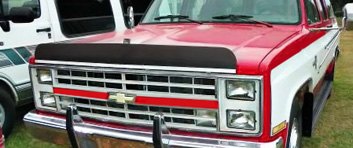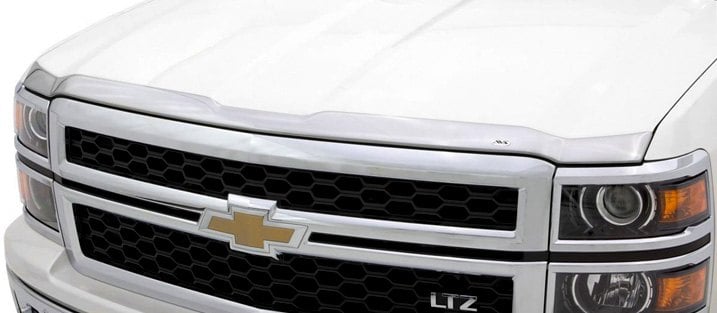The effectiveness of bug deflectors has been a point of contention between believers and non-believers for a long time. Some insist they work wonders, while others swear to the contrary. Because lots of testimonials supporting both points of view float around the internet and through word of mouth, deciding what to believe can be difficult. Before doing that, it's important to understand the thinking behind bug deflector designs.
By redirecting airstream upward at the front of your vehicle, the goal of deflectors is to carry bugs up and over the roof instead of directly across the hood and into the windshield. Bug deflectors don't make a large aerodynamic change, but anything that helps redirect air over your vehicle will increase mileage to some small degree.


In the early days, bug deflectors were basically tall, upright pieces of Plexiglas attached to the front end of a vehicle. Depending on the shape of your car or truck, sometimes they were effective - and sometimes they weren't. In more recent years, a great deal has been learned and understood about aerodynamics - and it's been applied to bug deflectors where it never was before. Modern design dictates taller isn't necessarily better, because the overall curve and shape of a deflector will produce equal, if not better, results than a tall, flat plank nailed to the front.
Deflectors are now "vehicle-specific", which means they are custom designed to fit individual makes and models. Because deflector angle and curvature is customized to the natural airflow of each specific vehicle, they can be extremely effective while complementing that vehicle's own design lines and maintaining an attractive appearance.

Skeptics will say that the difference between old and new bug deflectors is minimal. At best, they will grant newer deflectors a few points for looks. But the reality is that a good deflector made from high quality materials that's also custom designed for your vehicle will be effective and provide noticeable results.
Another benefit of bug deflectors is that even though you might notice bugs splattering against the deflector, you can also be sure that rogue road stones are bouncing off of it too. Pebbles and other debris that would end up chipping your hood are literally deflected away. In this article, we'll compare some of the bug deflectors we offer to help you make a more informed choice.
Tape-On vs. Bolt-On Bug Deflectors
Bug deflectors we sell mount in place using either screws or double-sided tape, and you'll see the method of attachment specified in the details of each product page on our site. Screw-on deflectors typically are shaped with a sleeve that fits underneath the hood, or they have brackets that do so. Either way, holes in the brackets will be positioned in order to allow you to use a vehicle's own pre-existing holes where the grille or hood molding is attached. Simply unbolt the trim piece, install the deflector, then reinstall and mount everything back in place.

Deflectors which are taped in place use 3M™ automotive-grade double-sided foam tape. This tape is strong and effective enough that many automobile manufacturers use it for attachment of chrome trim at their factories. A foam core allows the tape to conform to surface irregularities, and it allows expansion and contraction as temperatures fluctuate. Installation is extremely simple, because the tape comes with a protective backing that's peeled away before final installation.

All of the deflectors we sell are made from polymer-based compounds such as ABS plastic or acrylics. While the majority of them feature smoke tinting, some are available with chrome finish, clear finish, and other designs. When looking at bug deflector products, it always pays to check the Product Options field. There, you'll see any variations in product and finish that may be available for your specific make and model. In this article, we'll note the deflectors that are available in chrome, clear, and other finishes - otherwise, products referenced are standard smoke tint.
Low-Profile Bug Deflectors

Sometimes described as "off the hood" deflectors, these are designed to sit close to the hood in a snug, form-fitting way that matches the vehicle's own contours. Often, they resemble OEM trim more than add-on equipment. Since modern cars have lower hood lines than ever, their paint is more susceptible to rock chips. That's why we offer several deflectors that are made for a wide range of cars as well as trucks. For car models, the AVS Carflector Smoke Hood Shield is designed mostly for vehicles dating back to the early 1990s, and AVS's Acrylic Aeroskin Hood Shield and chrome finish Chrome Aeroskin Hood Shield offer a good car selection from 2004-on (as well as older trucks).


For trucks, SUVs, and some vans, there's the AVS Hoodflector Hood Shield and Stampede Vigilante Premium Hood Protector, and the AVS Aeroskin II Matte Black Hood Shield which has a textured matte black finish along with a bump-up ridge along the top to help with airflow without reducing overall style. Should you prefer a clear, non-tinted low-profile bug deflector, Wade offers the UltraGuard Bug Shield and Platinum Bug Shield. Note that both of these Wade products are produced in smoke tint for all models, while availability of the clear option varies by make and model.
Standard-Profile Deflectors
The so-called standard-profile bug deflectors are positioned further away from the hood panel, and may feature more of an angled profile. They're better if you live in warmer climates with larger bugs because they direct air further upward, increasing the odds that even tropical bugs will pass completely over your roof.


For starters, there's the WeatherTech Dark Smoke Stone & Bug Deflector that offers a great selection for trucks and compact cars with lower hoods that are more susceptible to damage from stones. For trucks only, there's the AVS Bugflector Hood Shield and Lund Interceptor Bug Deflector in smoke tint. If you prefer a choice of smoke tint or clear plastic that can be painted, we've got the AVS Bugflector Deluxe and Bugflector II. The Bugflector II is manufactured for a very wide variety of minivans and crossovers in addition to pickups and SUVs.


Stampede's Vigilante Premium Hood Protector offers the distinction of choices between smoke tint, clear, chrome, camouflage, and United States flag designs with or without an eagle on the front. And if you're interested in the look of carbon fiber, the GTS Omni-Guard Hood Deflector and Bug Guard Hood Deflector offer it for some models along with clear or smoke tint. For both these GTS products, enter make, model, and year then click on the top choice to be directed to another page where finish can be selected.

The GTS Smoke IKON Bug-Gard Hood Deflector features rugged-looking contours with the distinction of having a round center emblem that can be personalized with your own image. Putco offers chrome and smoke tint versions of their Element Hood Shield. Instead of a gentle sloping curve, Element deflectors are designed with crisply beveled edges that will complement the look of trucks with rugged styling of their own.

If you've got a Dodge Dakota or Durango model from 1997-2003, we've got a "fender eyebrow" deflector set designed especially for the lowered, separate areas above the headlights. Available in smoke tint, the AVS Fender Protector pieces attach with double-sided 3M tape. And finally, if you've got a 2007-on Jeep Wrangler, the Rugged Ridge Hood Bug Deflector is available in matte black finish. Smoke tint versions are also available for Wranglers and other Jeep models through 2010.


Bug deflectors are in fact, effective, but we also want to be realistic: they will certainly minimize, but not necessarily totally prevent, bugs from splatting against your windshield. They carry the added benefit of providing some hood protection, and frankly, the models we carry look quite stylish too! Best of all, installation is quick and easy.

